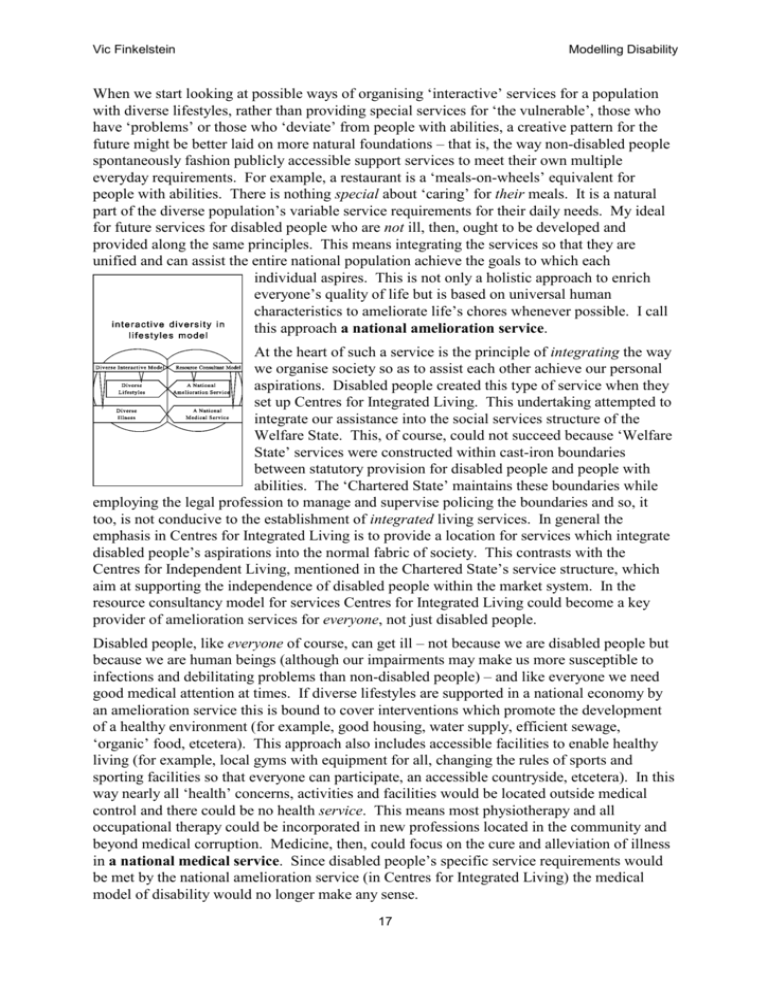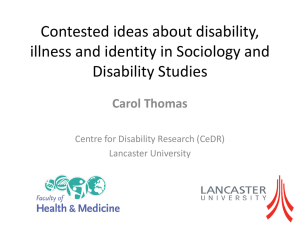Modelling Disability: tomorrow`s model
advertisement

Vic Finkelstein Modelling Disability When we start looking at possible ways of organising ‘interactive’ services for a population with diverse lifestyles, rather than providing special services for ‘the vulnerable’, those who have ‘problems’ or those who ‘deviate’ from people with abilities, a creative pattern for the future might be better laid on more natural foundations – that is, the way non-disabled people spontaneously fashion publicly accessible support services to meet their own multiple everyday requirements. For example, a restaurant is a ‘meals-on-wheels’ equivalent for people with abilities. There is nothing special about ‘caring’ for their meals. It is a natural part of the diverse population’s variable service requirements for their daily needs. My ideal for future services for disabled people who are not ill, then, ought to be developed and provided along the same principles. This means integrating the services so that they are unified and can assist the entire national population achieve the goals to which each individual aspires. This is not only a holistic approach to enrich everyone’s quality of life but is based on universal human characteristics to ameliorate life’s chores whenever possible. I call this approach a national amelioration service. At the heart of such a service is the principle of integrating the way we organise society so as to assist each other achieve our personal aspirations. Disabled people created this type of service when they set up Centres for Integrated Living. This undertaking attempted to integrate our assistance into the social services structure of the Welfare State. This, of course, could not succeed because ‘Welfare State’ services were constructed within cast-iron boundaries between statutory provision for disabled people and people with abilities. The ‘Chartered State’ maintains these boundaries while employing the legal profession to manage and supervise policing the boundaries and so, it too, is not conducive to the establishment of integrated living services. In general the emphasis in Centres for Integrated Living is to provide a location for services which integrate disabled people’s aspirations into the normal fabric of society. This contrasts with the Centres for Independent Living, mentioned in the Chartered State’s service structure, which aim at supporting the independence of disabled people within the market system. In the resource consultancy model for services Centres for Integrated Living could become a key provider of amelioration services for everyone, not just disabled people. Disabled people, like everyone of course, can get ill – not because we are disabled people but because we are human beings (although our impairments may make us more susceptible to infections and debilitating problems than non-disabled people) – and like everyone we need good medical attention at times. If diverse lifestyles are supported in a national economy by an amelioration service this is bound to cover interventions which promote the development of a healthy environment (for example, good housing, water supply, efficient sewage, ‘organic’ food, etcetera). This approach also includes accessible facilities to enable healthy living (for example, local gyms with equipment for all, changing the rules of sports and sporting facilities so that everyone can participate, an accessible countryside, etcetera). In this way nearly all ‘health’ concerns, activities and facilities would be located outside medical control and there could be no health service. This means most physiotherapy and all occupational therapy could be incorporated in new professions located in the community and beyond medical corruption. Medicine, then, could focus on the cure and alleviation of illness in a national medical service. Since disabled people’s specific service requirements would be met by the national amelioration service (in Centres for Integrated Living) the medical model of disability would no longer make any sense. 17 Modelling Disability Vic Finkelstein All the components of the model I would use in the construction of a non-disabling society are now in my kit box. However such a world can only become a reality when there is a fundamental shift in people’s greedy self-advancement and worship of the body-beautiful instilled by the Welfare and Chartered States. What is needed is the glue to hold the pieces together. For this I would use an aspirational culture. In my model for the future ‘who we are’ and ‘what we want to do’ would be valued. The goals we set for ourselves would be respected and support from a multiplicity of services would naturally be available to help everyone realise their aspirations. People who have impairments would not be disabled by the values and structure of a society designed for able-bodied living. It is disability arts that would have a special role in revitalising these positive qualities of humanity, presenting equalitarian values to a wider public arena and assisting everyone regain their sense of intrinsic worth. The emergence of a national aspirational culture, in my modelling kit, is very much dependent on the successful maturation of disability arts! If, however, disability arts goes no further than emphasise the experiences of being disabled (as the advocates of the rectified social model of disability now attach importance to) it will lack the creativity to fulfil its destiny in helping move society beyond the illusions of the Chartered State. An aspirational culture, then, is a vital item in emancipation and the reason why it was packed into the modelling kit many years ago. The model pieces are far from clearly moulded, pre-packaged for anyone to purchase, open, begin assembling and subject to emancipatory testing. Some pieces are still in their wrapping, waiting to be opened and made ready for gluing together with others. Some pieces are still unformed and need much attention before they are of use. There may be some pieces missing, which we will only notice when we try to fit them together. Some pieces have fallen into our box from other kits and will never belong in our model. Despite the imperfections in this kit, however, I believe we can now start to see the real dynamic shape of the social model of disability and intervention. Clearly, models provide no simple prescription for eliminating oppression. Nor do they explain why we come to be trapped in particular disabling situations. Used imaginatively, however, they can give us insight into old problems and raise the prospect of finding solutions which otherwise escape us. The social model of disability has been much admired and abused. Few, however, have actually opened the kit, unpacked the pieces and really begun trying to fit together this wonderful new tool. It is only when this interpretation of disability is repossessed by ordinary people, when they become the owners, when it is explored, manipulated, taken apart and reassembled that its full value will really be appreciated and its value become ingrained into our national personality. The social interpretation can then assist us to set goals for the future rather than merely act as a mirror of the present. 18








